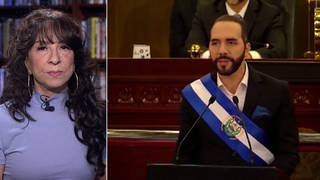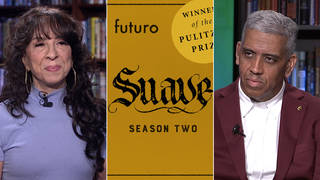
Guests
- Mustafa Hassanwitness to Malcolm X assassination.
- Ben Crumpcivil rights attorney.
This week, a witness to the assassination of Malcolm X in 1965 revealed for the first time that he overheard a New York police officer asking if Malcolm’s assassin was “with us.” The eyewitness, Mustafa Hassan, spoke Tuesday alongside Malcolm X’s daughter Ilyasah Shabazz and civil rights attorney Ben Crump at a press conference at the Malcolm X and Dr. Betty Shabazz Memorial and Educational Center. Democracy Now! spoke to Hassan at the press conference. He told us, “My testimony would have changed the outcome of the trial. It would have pointed the finger of guilt at the establishment.” We’re also joined on the show by Ben Crump, who calls this latest revelation “astonishing.” .
Transcript
AMY GOODMAN: This is Democracy Now!, democracynow.org. I’m Amy Goodman, with Juan González.
We turn now to look at the assassination of Malcolm X, shot dead inside the Audubon Ballroom February 21st, 1965. On Tuesday, a witness to the assassination revealed for the first time he overheard a New York police officer asking about Malcolm’s assassin, “Is he with us?”
The eyewitness, Mustafa Hassan, spoke Tuesday alongside Malcolm’s daughter Ilyasah Shabazz and civil rights attorney Ben Crump at a news conference at the Malcolm X and Dr. Betty Shabazz Memorial and Educational Center, housed in the former Audubon Ballroom. In February, the Shabazz family announced plans to file a $100 million wrongful death lawsuit against a number of institutions, including the FBI, the CIA, the New York Police Department, concealing evidence of their involvement in the assassination.
At the time of Malcolm’s assassination, Mustafa Hassan was a member of the OAAU — that’s the Organization of Afro-American Unity — part of Malcolm’s security detail. Hassan later fled the country, fearing for his life. He described what happened inside and outside the ballroom when Malcolm was shot.
MUSTAFA HASSAN: There was a loud explosion that immediately caused further disruption, capturing everyone’s attention. Now, a series of gunshots, number 10, then rang out from another direction, and I immediately ran from my post in the entrance and witnessed Malcolm X being shot. Number 11, I immediately started to make my way from the back of the Audubon, where I had been posted, and towards the stage, where Malcolm X was located. However, the scene became chaotic as people frantically ran around seeking exits to cover and protect themselves.
Number 12, I saw a man running down the aisle, towards the exit where I had been posted, with a gun in his hand. I made the decision to attempt to stop this person, because he had a gun in his hand and was heading directly towards me. Number 13, I managed to knock this person down, and I continued towards the stage, where Malcolm X was lying on his back, surrounded by his followers. I know now that the identity of the man with the gun is Talmadge X Hayer, also known as Thomas Hagan.
When I arrived at the stage, I saw that Malcolm X was in grave condition, seemingly close to death, and as a result, my extreme distress and anger, I turned attention back to the man who I had seen running away, knowing that he had a part of responsibility for what I had just witnessed.
Number 16, I would later see the same man outside as he was being beaten by Malcolm’s followers, while a group of policemen who suddenly showed up on the scene asked if he was “with us,” while at the same time holding back Malcolm’s followers from beating him.
BENJAMIN CRUMP: Can you repeat that?
MUSTAFA HASSAN: Yes. I would later see the same man outside as he was being beaten by Malcolm’s followers, while a group of policemen who suddenly showed up on the scene asking, “Is he with us?”
AMY GOODMAN: That was Mustafa Hassan reading from his own affidavit. He was inside the Audubon Ballroom when Malcolm X was assassinated 58 years ago, 1965. During Tuesday’s news conference, I had a chance to question Mustafa Hassan.
AMY GOODMAN: Did you ever approach the police or the FBI, the authorities, to share what you had seen?
MUSTAFA HASSAN: No, no and no. No.
AMY GOODMAN: Because?
MUSTAFA HASSAN: Because —
BENJAMIN CRUMP: They had just killed Malcolm.
ILYASAH SHABAZZ: Terrorism, trauma.
MUSTAFA HASSAN: Because, in my belief, they were the perpetrators. And they knew more than I did, as a consequence of being the perpetrators of the event. Why would I go to them? And for whatever reason they call me, as the attorney stated — the reason that they failed to call me would have been that my testimony would have changed the outcome of the trial. It would have pointed the finger of guilt at the establishment.
AMY GOODMAN: That was Mustafa Hassan, speaking Tuesday about the assassination of Malcolm X.
Three men were later convicted of killing Malcolm X. One was Talmadge Hayer, the man Mustafa saw shoot Malcolm. Two other men, Khalil Islam and Muhammad Aziz, were arrested and imprisoned for decades, after being falsely accused. In 2021, the two of them were exonerated. By then, Khalil Islam had already died, and Muhammad Aziz was 83 years old.
We’re joined now by civil rights attorney Ben Crump, representing Malcolm X’s family.
Ben, welcome back to Democracy Now! Talk about the significance of this testimony for the first time being heard, this eyewitness account of Mustafa Hassan, and where this fits into the lawsuit you’ll be filing.
BENJAMIN CRUMP: Well, thank you for having me, Amy. And thank you for being at the press conference.
Mustafa Hassan’s testimony, for the first time in 58 years, is astonishing, especially the level of detail that he chronicled, that was corroborated by the photographs, as well as the stock video, that when the convicted murderer, Talmadge X, was being manhandled by Malcolm’s supporters, who had just witnessed him kill Malcolm X or shoot Malcolm X, the police ran up, and they were asking, “Is he with us?”
And then, as Mr. Mustafa Hassan believes, they were trying to help get him away, where he could escape from the Black supporters of Malcolm who was trying to make sure that he was captured. And so, Mustafa — and you see it in the photographs — grabs onto his collar very tightly. And the police seem, as the photographs suggest, to be trying to separate him from the person who they had just saw shoot Malcolm. And this is Mustafa’s belief. And when he puts it in context that the police are saying, “Is he with us?” it suggests to him that the police were involved.
Now, Amy, this is what we are arguing is completely new evidence that has never been presented before, this new information, and the fact that we know fraudulent concealment is a theory that will allow us to toll the statute of limitations and for Malcolm’s family to have a chance at getting some measure of justice after all these years, because we know that the government concealed the fact that they had multiple informants in the Audubon Ballroom on May 21st, 1965, when Malcolm was assassinated.
So, essentially, those informants were kept isolated, those New York Police Department undercover officers, like Eugene Roberts and Ray Woods, were all kept isolated from one another. And the police, we believe, knew, when they arrived on the scene, that they had undercover informants in there, and they didn’t know what their assignments were, and they didn’t know who they were, but they were told some of the Black people are undercover informants. And that is why Mr. Hassan said they were saying, “Is he with us?”
JUAN GONZÁLEZ: Well, Benjamin Crump, why has it taken over 58 years for this to come forward? Could you tell us a little bit about who Mustafa Hassan is and perhaps why he was never questioned?
BENJAMIN CRUMP: Well, obviously, he was a young man who believed in the principles and philosophies of Malcolm X. He was a member of the OAAU, and he was a person who believed that Black people had a right to self-determination, and that the American government cannot continue to oppress us and deny us liberty. And so, after they killed Malcolm, like so many people in America, especially Black Americans who believed in the principles that Malcolm X was trying to articulate to the world, that he left America, and for not just his personal safety but his family’s safety. And as he stated, he was worried about where America was headed to as a society.
And so, he left for months, came back and saw that they were having this trial. The police never approached him. The prosecutors never approached him. He was readily identifiable on all the photographs, all the video. Everybody knew that he was a part of the OAAU. They had sign-in for the registrations and so forth. And so, it was clear that had they wanted him to testify about everything he saw firsthand, he could have. But they never did that. And we think that is more telling than anything.
AMY GOODMAN: Very quickly, Ben, before we move on to another subject about where you are right now — you’re a Florida resident — I wanted to ask you about the state of the lawsuit. You are suing federal authorities, CIA, FBI, New York state, New York City, the NYPD, talking about all of those agencies involved. The two men who were exonerated, although they had served decades in prison — one dead, one still alive — have settled for millions of dollars. Will you be able to use information based on their settlement for the — in pursuing this $100 million settlement for the Shabazz family?
BENJAMIN CRUMP: We believe, Amy, we will be able to use a lot of the discovery that the great lawyers with the Innocence Project, Barry Scheck and others, used to help exonerate those individuals and help them get their compensation, because the concealment affected their liberty, but it also affected Betty Shabazz’s inability to be able to bring a wrongful death lawsuit for the assassination, the conspiracy to assassinate her husband, the minister Malcolm X.










Media Options